
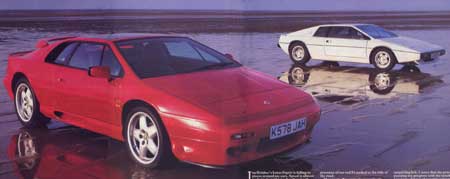
Sand Wedge
The Original and the Best? We compare the first Esprit with the new S4
Performance Car April 1993
by David VivianIan Helsbey's Lotus Esprit is falling to pieces around my ears. Speed is almost exclusively to blame. Another 5mph through the photographic corner and suddenly the entire upper half of the driver's door seal springs free and flails about the cabin as if guided by a double glazing salesman enacting a flagellation fantasy. I stop to stuff the rubber back in place but it's harder than putting the lid on a Tupperware lunchbox and the door won't stay open.
Garlanded with tubular rubber, I splutter uncertainly back to the spot where, on a deserted road midway between Liverpool and Southport, Ian's posse of onlookers are alternately witnessing the gradual disintegration of their friend's part-restored S1 and admiring the pristine presence of our red S4 parked at the side of the road.
The young, flat-capped scouser's oil-stained fingers work swiftly to restore the status quo seal-wise but there's little he can do to reacquaint a small laminated Lotus badge with the top of the gearknob. When it stuck to the palm of my admittedly sweaty hand I placed it carefully on the passenger seat but, unsurprisingly, it slid off and into the black abyss of the footwell at the first sniff of a bend.
Back to work. Again the preposterously heavy clutch and sticky throttle action conspire to serenade my getaway with crescendo of wasted revs but, once the plates bite and the 2-litre, 160bhp, twin Dell'Orto carburettored 16-valver clears its throat, we move down the road at a surprising lick. I sense that the posse is panning my progress with the synchronised precision of massed security cameras, so redouble my efforts and lunge into the bend with a further 5mph showing on the clock.
The Esprit takes it with grace to space, like Gene Kelly swinging round a lamp post in Singing In the Rain. But the sudden surge of lateral g dislodges a major item of leathercloth-wrapped interior trim which thumps into the facia and falls to the carpet.
Every time I reverse, the back end shudders the shudder of a Stephen King pot boiler. When I apply the brakes there's no guarantee they won't stay applied. This particular Series 1 Esprit has been on fire more times than a dozing New York underground commuter. It read 61,000 on the odometer but that's just plain nostalgic.
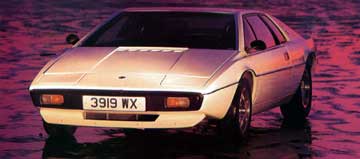
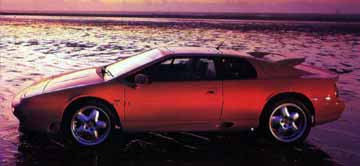
To be perfectly honest, it's a wreck. And to be fair, Ian knows it: so far, he's only done the bodywork and paint – the major part of the restoration lies ahead. If Lotus ever wanted to find a single car that embodied all the horrors of poor build and even worse reliability ever laid at its doorstep, this probably comes as close as any. It isn't hard to understand how the Esprit and the nadir of the Norwich-based car maker's credibility arrived at about the same time.
And yet . . . and yet. Despite the airborne trim, the trembling transmission, the binding brakes and the serpentine door seal, Ian's Esprit handles beautifully. No, really corners. Perhaps with a little more understeer than it says in the textbook of optimum chassis dynamics but such benign, well telegraphed understeer, it hardly matters. The steering's responses may not be as sharp as they were but it still has its full measure of feel and, if you time the application of power well, the tendency to run wide can be transformed into a gloriously neutral drift. It isn't hard to achieve: not with such immediate throttle response (no turbo lag to contend with) and the generous slip angles of the tall aspect ratio tyres – 195/60 HR 14s front and 205/70 HRs back.
Ian's Esprit is 17 years old. If the last things an ageing boxer loses are his weight of punch and his class, it must be true that Lotus's classic mid-engined supercar hangs on to its exceptional handling, the quality of which shines through the tired plastic with the intensity of an arc light. And, of course, its good looks. Lotus has softened, curved, fluted, ducted and spoilered the Esprit's shape over the years but for sheer, in your face, drama, Giugiaro's original has it by a mile. All right, the Wolfrace wheels are naff but just look at the audacity of the thing, the purity of purpose, the economy of line. You know exactly what Giugiaro was getting at.
Even today, the front end is as distinctive as anything on the road, the acute rake of the windscreen diving on to a steep little bonnet which, in turn, tapers down to a delicate rail of black plastic. The shallow snout and vestigial blade of a chin spoiler complement each other perfectly; the subtle kick of the tail is barely less effective. It looked great as James Bond's company car in the 1977 movie The Spy Who Loved Me, even as a submarine: better than the ski-festooned Turbo in For Your Eyes Only, better than Sharon Stone's S3 Turbo (actually two SE's, LEW) in Basic Instinct.

Not that Ian and the posse necessarily agree. In the £46,995, 165mph S4, launched at the Geneva show in March, they see the ultimate evolution of the perfect predator.
They look at the gaping mouth carved into the deep front spoiler, the shark-like gill detail just in front of the wheelarches, the ovoid ducts scooped out of the sills, the Ferrari-esque 17-inch alloy wheels and the unexpectedly modest (though strikingly positioned) secondary tail aerofoil and see all the hallmarks of a contemporary big league exotic. One that, through sheer force of development, can trade punches with the fastest production cars in the land.
I don't think it's as handsome as the S1 (however fancy the air dam, it doesn't disguise the perfunctory styling of the nose introduced with the post-S3 'new shape' and the new scoops and wings look faintly ungainly from some angles) but its image is more appropriately resolved for the '90s. And now that GM-owned (for the time being) Lotus isn't making the front-drive Elan, the latest Esprit is more than ever the company's definitive statement – until its promised McLaren-munching mega car breaks cover, unequivocally its best shot.
The closer you look the more you see how hard Lotus has tried with the S4. The old Morris Marina door handles have finally been introduced to the bottom of a dustbin, replaced by infinitely nicer colour-keyed components from the GM collection. Inside, you don't need a train spotter's mentality to notice the smattering of switchgear from the same source – all vastly preferable to the uneasy hotchpotch of '60s control tackle considered adequate before. As, on balance, is the liberal use of carbon-fibre composite-style matting in place of the previous SE's polished wood. What's undeniable is the new feeling of quality, integrity and attention to detail the changes bring, though whether, as Lotus's interior designer David Brisbourne claims, the new hi-tech look is 'refreshing' is open to question. It may have been refreshing in the Panther Solo, it still sated a desire to be different in the Alfa RZ but, well, in the S4 I'm just not that thirsty any more.
Brian Angus, the S4's project manager, strikes an interesting note when he talks about 'rediscovering the purity of the original Esprit, both in looks and performance'. Interesting when you consider that the supercar envisioned by the late Colin Chapman remained an ideal while, at best, the S1 turned out to be an artful compromise. Chapman originally wanted to build the Esprit in two forms; one with a high-efficiency four-cylinder engine, the other toting a small block V8. The energy crisis of the mid-70s had other ideas and, in league with tougher worldwide safety legislation, forced Lotus to build a bigger, heavier, slower and more expensive car than it would have liked. A prototype V8 was built but the fuel injection development costs were prohibitively high and the big V8 was put on ice. Instead Lotus ploughed the resources at its disposal into turbocharged version.
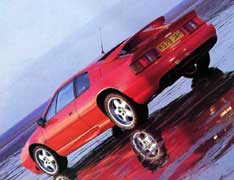
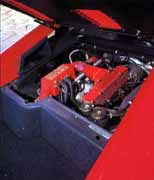
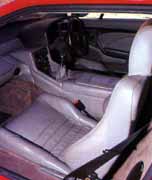
The birth of the Turbo, as an addition to the normally-aspirated S2 in 1980, presaged its baptism as a serious supercar and, 13 years on, any remaining smudges of ambiguity over the matter have been ruthlessly expunged. Quite simply, as the S4, it is the most spectacular celebration of intellect over muscle in supercardom. With just 2174cc and four cylinders, it develops a nominal 264bhp – the engine management allows up to 280bhp if running conditions are cool, a staggering 120bhp more than the S1's output. Which is the same figure as the specific power output of 120bhp/litre, the highest of any car made. The power/weight ratio of 232bhp/tonne allows it to accelerate from 0-60mph in around 4.7 seconds – faster than a Ferrari 512TR.
For the S4, the 17-inch road wheels are respectively 2 and 1 ins larger than the superseded SE's and wear specially made Goodyear Eagle GS-A asymmetric tread tyres – 215/40s on 7ins wide rims at the front, 245/45 and 8.5ins rims at the back. According to Lotus's associate director of vehicle engineering, Roger Becker, the unique Goodyear tyres work particularly well with the new Lotus/Saginaw power steering system, used for the first time on the Esprit. 'The power steering took two years to develop,' he says, ' and balances the increased response from the new tyres. We've taken the zero-dive characteristics out of the front suspension and through a combination of new geometry, adjustable castor and camber and new springs, anti-roll bar and dampers, reduced the understeer.'
He's right, of course. The new car's turn-in is electric, its grip a miracle. At cornering speeds where the S1's understeer is telling you something you need to know, the S4 is still warming its fat, flat tyres. I add 5, 10, 15mph to the top speed through the bend and it swallows them whole: no effort, no squeal. Eventually – at speeds that have the posse rubbing its eyes – I start using more lock to pull the nose on to the apex, but the effect is felt rather than seen. And there's always the option of balancing the act with your right foot.
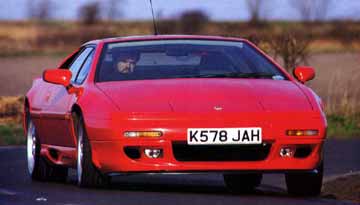
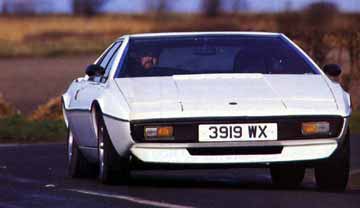
As with the S1, when you feed in the power is all important. But whereas you need all the S1's simply to get rid of the understeer, you need only two-thirds of the S4's to set the rear tyres alight. If your planning includes a degree of anticipation for the lag (despite the reprogrammed engine management computer, it still exists) it's possible to curb the excess and balance the S4 on the throttle in a way that would have been hard with its predecessor.
Ability of this order and comfortable ride are mutually incompatible and, on poorly-surfaced urban roads, the S4 does a passable impression of Porsche's board-hard 911 Carrera RS. Its high speed suspension control is similarly breathtaking and, so well shaped and supportive are the seats that body of driver and car tend to move as one.
After 500 miles at the wheel – 400 of them on motorways – the only thing that ached was my right ankle, and then at having to crank it back far enough to sustain a light throttle opening. For someone of my size (5ft 8ins) the driving position is otherwise hard to fault: the glass sunroof liberates a crucial inch of headroom, the clutch (considerably lighter than the S1's) doesn't require you to shift your body mass to press it all the way, the shift of the new, high-torque five-speed gearbox is short and snappy, and all the instruments are visible through and above the exquisite leather-bound three-spoke wheel.
But after 17 years, it's still the handling that makes your day. That and the way it gels with the startling performance to give you a full frontal glimpse of 'what it's all about'. It's a trick, of course. Esprits have always looked the part but none of them has ever delivered that multi-pot, multi-cam buzz you get with the top Italian and German machinery – not even the gorgeous S4. When it comes to neck-tingling charisma, Britain's boldest and longest lived supercar has always fallen slightly short.
There gain, such things are often a matter of perception. It might be that S4 buyers just have an unusually low tolerance to bullshit.
THE RED CAR
The first Esprit prototype was silver and based on a cut and shut Europa chassis. Essentially it was a rolling chassis on which Giugiaro could develop his ideas for the project M70. He had the car display (rather than running) trim in 1971.
The now famous 'red car' was the second Esprit prototype and ran during 1972 and '73. Registered 'IDGG 01', the name 'Esprit' had yet to be decided on though and strong resemblance it bears to the series 1 production car is clear for all to see, right down to the distinctive Wolfrace alloy road wheels.
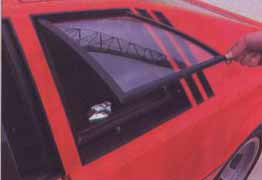
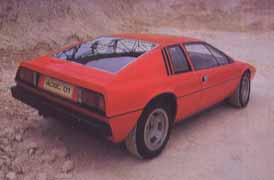
But look closely and you'll spot numerous detail differences. Most obviously, the 'red car' had its radiator in a pod beneath the bumper and its petrol filler cap just inside the rear window. Numerous facets of the car were 'productionised' – not least the petrol filler caps which were moved out on to the upper flanks – but the Morris Marina door handles survived right through to 1993 and the introduction of S4.